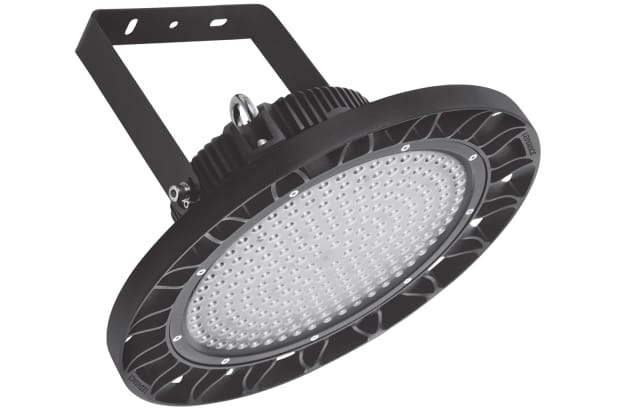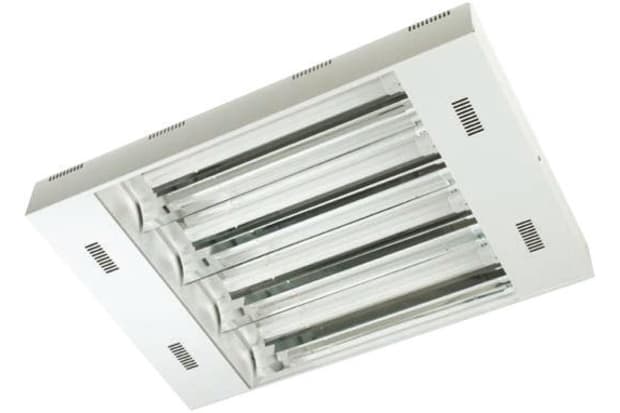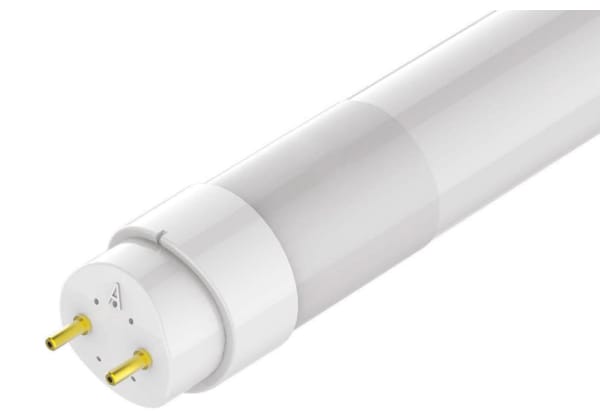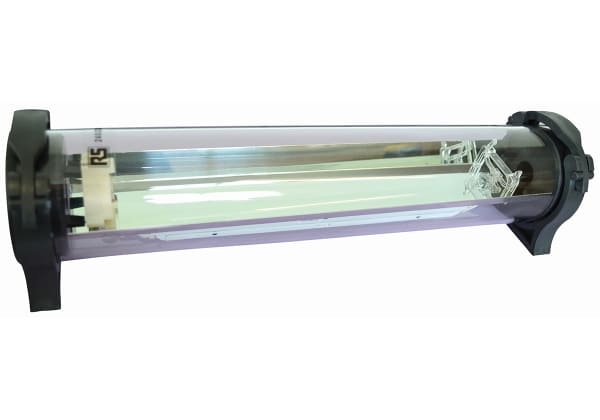- Published 5 Jan 2023
- Last Modified 29 Aug 2023
- 16 min
The Complete Guide to Industrial High Bay Lighting
Discover how to achieve optimal illumination and efficiency in industrial spaces with our comprehensive guide to high bay lighting and its application in various industries.

Reviewed by Tekena Ojimba, Technical Support Engineer (March 2021)
Welcome to our comprehensive guide to high bay lighting. Whether you're tasked with lighting a warehouse, a manufacturing facility, or any other large-scale space, understanding the different types of high bay lighting and their ideal applications is essential.
In this guide, we'll provide you with the knowledge you need to make informed decisions about the various configurations available, ensuring that you choose the most suitable lighting solution for your specific environment.
What is High Bay Lighting?
Many workplaces choose high bay lighting to provide uniform, bright illumination across large and high-ceilinged indoor areas. It can be found in sports halls, manufacturing facilities, warehouses, and department stores.
But what is high bay lighting, and how does it differ from other high-intensity lighting solutions?
Rather than any single fixture style, high bay lighting refers to the positioning of the luminaires. As such, the high bay lighting definition covers a broad and flexible range of lamp types and fittings. As a rule of thumb, high bay lighting is usually the most suitable option for any indoor setting where the floor-to-ceiling height measures 8m (roughly 25") or taller.
For less lofty spaces, low bays (or even a series of appropriately arranged floodlights) may be enough to get the job done. But, where indoor work areas span a lot of vertical and horizontal space, the lighting solution needs to be both powerful and flexible.
Low Bay or High Bay Lighting?
Low bay lighting setups are more commonly used where there’s less vertical distance for the light to cover. In these situations, lower mounting positions often allow for a shallower lighting angle. This makes it easier to illuminate vertical surfaces or create specific lighting effects in smaller zones.
High bays are most often found in warehouses, gantries, above large shop or conference floors, at sports facilities, in expansive factory or workshop environments - anywhere that needs uniform, brilliant illumination to maximise visibility and light quality over a wide area.
Apart from the different mounting altitudes, another key contrast between high bay and low bay light setups is that high bays tend to require more careful consideration of layout, fittings and components. High bay lighting must be chosen and positioned to ensure the light they cast is strong, uniform, and equally effective at hitting both vertical and horizontal surfaces from a wider angle.
To achieve this, high bay lighting demands more exacting lamp and reflector placement. When configured properly, high bay setups can achieve superb quality and intensity of light across a wide, tall space.
Low Bay vs High Bay
When considering low bay vs high bay lighting, some key points to remember are:
Low Bay Lighting
- Typically low-powered and used in indoor spaces where the mounting position is less than 20 feet from the floor. Above this height, they tend to produce spotting or pooling effects on distant floors
- Individual luminaires are usually located closer to one another than in most high bay setups
- Generally requires less intricate planning to achieve proper illumination of vertical surfaces (such as goods stacked on shelves), due to casting its light at a shallower angle
- Fixtures often incorporate a designer look, as they’re more visible from ground level than most high bay mounts
High Bay Lighting
- More powerful and better suited to larger or taller spaces, typically with ceiling heights of 20-45 feet
- Ideal for use in harsher or more corrosive indoor environments, such as above manufacturing floors, where higher concentrations of airborne particulates may occlude weaker lighting or damage less robust fittings
- Can require careful positioning and the use of reflectors to achieve appropriate illumination of vertical surfaces, especially when mounted at the highest point of a bay
- Can also be positioned at lower mounting heights where necessary, to achieve more intense illumination over a narrower distribution area
- High bay LED lights are typically available in simpler, more industrial styles
Types of High Bay Lighting
There’s a wide range of high bay lighting setups available. Each has its own unique benefits or potential limitations, depending on the demands of the space and the types of work being carried out.
LED High Bay Lighting
LED high bay lighting is at the cutting edge of workspace lighting setups. It is ideal for large warehouses, factories, production, commercial, or service areas. The initial investment in a high bay LED setup will be more expensive than most other fixture types. However, once installed, long-term running costs are minimal.
Energy efficiency is also vastly improved, resulting in anywhere from 50-80% lower bills (depending on the specifics of the setup and intensity of use), and the lifespan of an LED bulb is typically many times longer than that of metal halide or fluorescent lamps.
High bay LED fittings illuminate to full intensity instantly, rather than warming up like many other lamp types. They’re also suitable for use with microwave sensors without degrading the lamp lifespan, which allows for true wide-aspect motion detection over large areas.
T5 High Bay Fluorescent Lights
The ‘T’ in T5 refers to the tubular shape of the fluorescent lamp, while the ‘5’ indicates a tube diameter of ⅝”. T5 high bay fluorescent light fixtures have emerged in recent years as an increasingly popular alternative to the traditional T8 (1”) configuration. This is due to the improved efficiency and reduced heat radiation of smaller gauge tubes. However, this also results in a narrower beam angle, making the T5 suitable for more intense lighting over a smaller area.
T8 High Bay Fluorescent Lights
T8 high bay fluorescent lights are the more traditional configuration of the standard tube strip. They have a 1” diameter and excellent colour rendering, making them particularly suitable for commercial, servicing, and workshop setups. The wider gauge also means the beam angle will be less acute. This means the light they give off is more diffuse and even (though slightly less intense) over a wider area than their smaller T5 counterparts.
Be aware that the different standard fittings for T5 and T8 high bay fluorescent lights don’t usually allow for a straight swap between the two tube types, so you’ll need to know what hardware changes are required if you’re considering an upgrade or a switch.
Plasma High Bay Lighting
Plasma high bay lighting generally offers longer bulb lifespans, improved colour rendition, higher lumens and better dimmable performance than traditional HID lamps (such as metal halide or sodium).
Plasma setups are less expensive to install than a full LED system but often deliver comparable light quality and intensity - albeit with a few more limitations in terms of adaptability (they operate within a finite range of orientations) and overall efficiency. Also suitable for use with true motion sensor technologies, plasma high bays are an excellent choice for many work environments where full freedom of orientation isn’t necessary.
Retrofit High Bay Lighting
Retrofitting refers to upgrading an existing high bay lighting setup with more powerful, modern, or efficient lamps. In most cases, this tends to mean an LED high bay lighting retrofit, by far the most common type of retrofit we see today.
Your potential for a high bay lighting retrofit relies on the compatibility of your existing fixtures. It also relies on the range of energy-efficient lamps available in the sizes and specifications you need. Options are expanding all the time, with a number of popular manufacturers now offering their own product ranges suitable for an increasing number of retrofit jobs.
High Bay Light Applications
High bay lighting is used wherever large expanses of indoor space make it difficult to achieve bright and uniform illumination across the full work area. Ideally suited to this purpose, high bays are usually powerful fixtures that can be configured in a wide variety of setups to suit the precise needs of the user and the environment.
High bay lights are available in numerous fitting and reflector types, ranging from LEDs to metal halide bulbs, fluorescent tubes and plasma lamps. Different sorts of reflectors and fixture positions will deliver markedly different results, from intense overhead spotlighting effects to a softer, more diffuse glow spread over a wider area.
Whichever configuration is best suited to your needs, remember that efficient lighting is first and foremost about safety and precision. In planning the installation of any high bay lighting setup, it’s crucial to consider the unique aspects of the environment in question, as well as the specific nature of the tasks being carried out in it.
Warehouse Lighting
Warehouse lighting is one of the most common high bay light applications. Huge interior dimensions can make these spaces extremely challenging to illuminate uniformly. Stacked goods and tall shelving can create areas of deep shadow that many low bay solutions struggle to penetrate.
There are dozens of different configurations to choose from when installing warehouse high bay lighting. Given that many such workplaces operate 24 hours a day, LED high bay setups have become very popular due to their significantly lower running and maintenance costs over time.
The initial outlay is usually higher than with traditional lamp fittings. However, LEDs require much less frequent replacements and consume only a fraction of the power while delivering more intense and consistent illumination quality.
Traditional incandescent, fluorescent or metal halide lamps are also appropriate choices for many aspects of typical warehouse lighting. However, remember that all of these alternatives will require more regular replacement and draw increased power compared to their more efficient LED counterparts.
Shop Lights
One of the most common setups found in high bay shop lighting today is the widely used T5 or T8 fluorescent tube lamp. These are often seen mounted high above shop floors, usually recessed beneath large concave reflectors. This helps them deliver bright and uniform lighting across wide areas. They’re particularly common in environments with glossy, polished, or reflective surfaces. This suits fluorescent lamps' flat, colour-neutral, and widely dispersed light quality.
Industrial High Bay Lighting
Industrial high bay lighting fixtures are another area where modern LED configurations have gained major traction in recent years. This is largely because safety, precision and quality are key concerns in all industrial environments. Instant-on functionality and suitability for microwave activation sensors are both significant advantages of LED industrial high bay lighting.
Adaptable lighting setups are also valued in industrial settings. LEDs are streets ahead of traditional lamps in that regard, often allowing minute adjustments on the fly. This allows users to create vastly different lighting qualities and intensities in different zones of the workspace.
Again, the 24-hour nature of many industrial and manufacturing facilities often means the higher initial investment in LED lamps is quickly offset by their far lower running costs. Vastly improved longevity and reliability also result in minimal downtime; another worthwhile consideration on fast-paced production lines.
Loading Bay Lighting
A high-functioning, safe, and efficient loading bay is one of the most critical links in the smooth supply chain of any warehouse, industrial, logistics, or large retail space. Demand for around-the-clock access to these busy work areas makes installing a robust, well-planned loading bay lighting solution absolutely vital. Suitable loading bay setups must effectively light all general goods handling, traffic and transfer zones to maximise worker safety and efficiency.
It’s also imperative to consider where additional functionality might be required to meet the exacting demands of a multi-space loading bay. Adjustable dock guide lights, for example, are extremely helpful in illuminating the interior of vehicles, crates, and containers. This helps reduce the risk of damage or injury as a product is brought in and out.
Garage Lights
High-quality garage lighting is crucial for maximising efficiency and quality of work, as well as for standing up to the challenges of a shop floor or service area that lower-grade setups might struggle with. Particulates, fumes, and other pollutants can quickly occlude or damage high or low bay fixtures that aren’t up to the rigours of the environment. This results in severely compromised quality and consistency of lighting.
Popular choices for high bay lights in garages, workshops, and servicing facilities include fluorescent and LED lamp setups. This is due to their suitability for use in environments where excellent colour rendition and minimal glare are needed to achieve the highest standards of craftsmanship, finishing and attention to detail.
High Bay Fixtures and Fittings
Just like with the numerous varieties of high bay lamps themselves, there’s a wide range of high bay fixtures and fittings available when planning a lighting configuration for a large and high-ceilinged workspace.
T Bay Lighting
T-bay fixtures are similar in design to recessed lighting often seen in offices and retail spaces, but they can be surface mounted or suspended from ceilings. Typically based on a familiar multi-tube setup, nowadays it’s common to see various configurations of LED tubes used instead of standard fluorescent T8s or T5s. T-bay lighting is a popular option when retrofitting older infrastructure. They make suitable replacements for older-style HID high bay lamps due to their much-improved efficiency, without compromising light quality or warm-up time.
Troffer Lighting
A strange-sounding term that not everyone knows - so what is troffer lighting? You’re probably used to hearing it called recessed lighting, which explains it. A troffer light is simply a lighting fixture embedded into the ceiling grid that retains a fixed and permanent position.
HID Lighting
HID (High-Intensity Discharge) lighting has long been a common standard across many high bay setups and remains an attractive option in scenarios where the extra initial cost of LED alternatives won’t quickly be offset by reduced energy bills. Bright, intense, and notable for the high colour temperature typical of most gas-discharge arc lamps, HID high bay lighting setups are an effective choice wherever large floods of sharp light are needed over a wide area. However, a much slower warm-up time and lower efficiency rating mean they’re not always the ideal solution for every environment, particularly where instant illumination or very prolonged use is needed.
What is the Best High Bay Lighting?
With so many different types of high bay lighting available, it can be difficult to know which one to choose. Additionally, the best high bay lighting depends on various factors such as the specific needs of the space, the desired lighting levels, energy efficiency requirements, and budget considerations. There isn't a one-size-fits-all answer to this question.
One of the most popular types is LED high bay lighting. When selecting the best LED high bay lights, it's crucial to consider factors such as light output, energy efficiency, durability, warranty, and the specific requirements of your space.
Other options for high bay lighting include metal halide fixtures and fluorescent high bay lights. Each type has its own advantages and considerations, so be sure to conduct thorough research. This will enable you to determine the best high bay lighting solution for your specific application.
Popular High Bay Lighting Manufacturers
Here are some of the most popular brands of high bay lighting we offer:
High Bay Lighting Layout
Effective high bay lighting design involves strategically arranging the fixtures to ensure optimal light distribution, uniform illumination, and appropriate lighting levels for the specific application.
High Bay Light Spacing
Determining the proper spacing for high bay lights involves considering the size and layout of the space, the mounting height of the fixtures, the desired lighting levels, and the specific tasks or activities being performed in the area. Here are some steps to determine the right high bay light spacing:
- Determine the mounting height: Measure the distance from the floor to the bottom of the high bay light fixtures. The mounting height determines the spacing between the lights
- Identify the desired lighting levels: Determine the recommended Lux levels for the specific application. Different applications may have different lighting level requirements
- Consider the light distribution pattern: High bay lights come with different beam angles and light distribution patterns, such as narrow, medium, or wide. The choice of light distribution pattern will affect the spacing between fixtures. For instance, narrow beam angles may require closer spacing to achieve even lighting, while wider beam angles may allow for greater spacing
- Calculate the spacing: Manufacturers often provide high bay lighting layout recommendations based on mounting height and desired lighting levels. These recommendations help determine the optimal spacing between high bay lights
- Adjust for specific requirements: Consider any specific requirements or constraints of the space, such as obstructions, aisle widths, or any areas that require additional lighting focus. Make adjustments to the spacing accordingly to ensure uniform and adequate lighting coverage
FAQs
Summary
There are many variables to weigh up in terms of available products, mounting solutions and short/long-term cost-effectiveness when deciding on a high bay lighting setup for your large, high-ceilinged workspace.
Whether you opt for standard low-cost HID lamps or the longer-lasting and far more energy-efficient LED versions, a properly planned and installed high bay lighting system will give you excellent coverage and quality of light across an expansive area. This will, in turn, make large indoor zones safer and more comfortable spaces to perform high-quality, efficient work.






